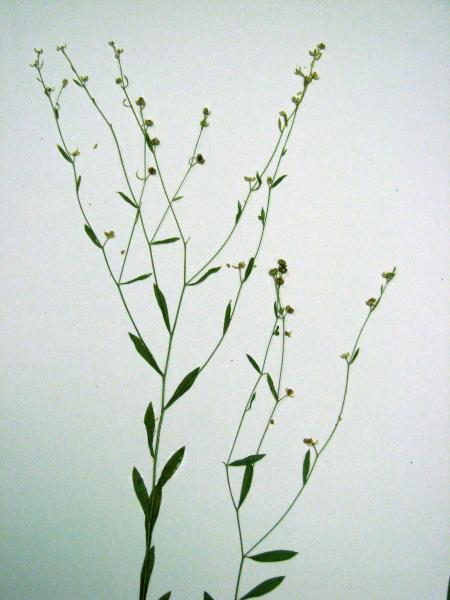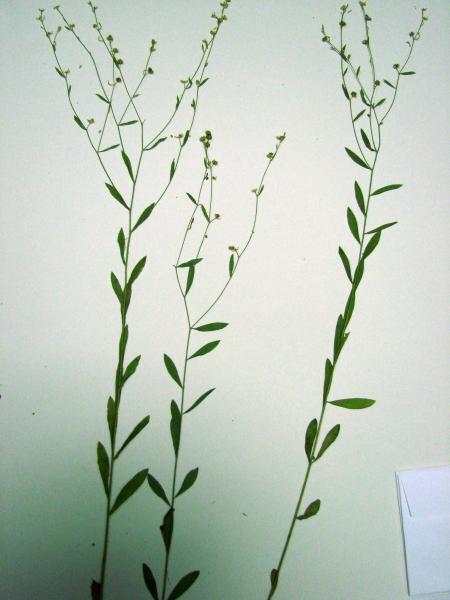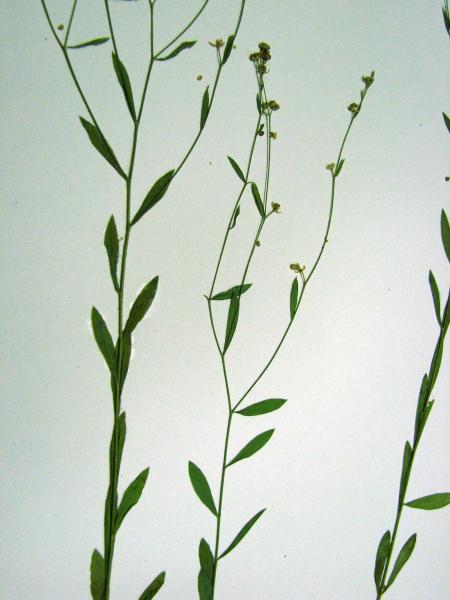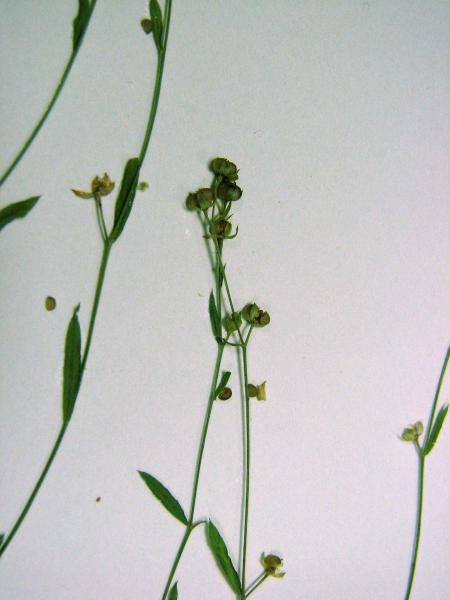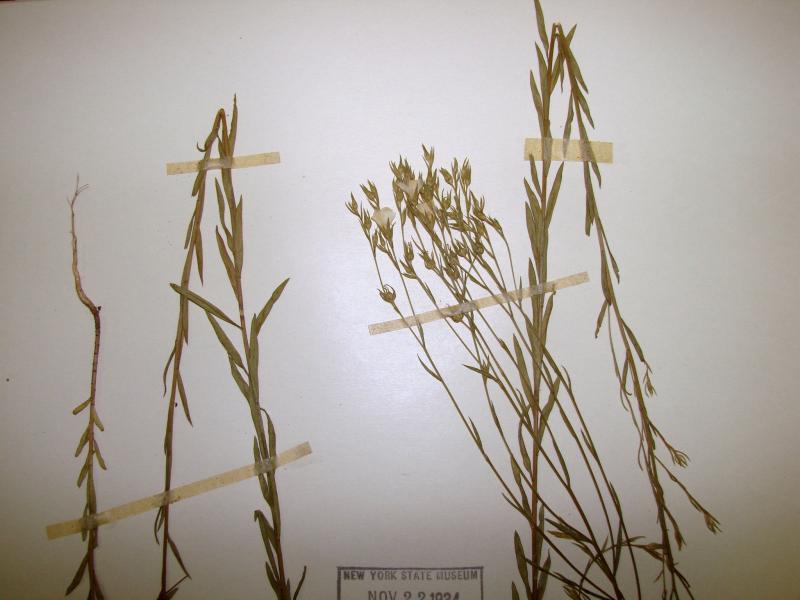Texas Wild Flax
Linum medium var. texanum (Planch.) Fern.
- Class
- Dicotyledoneae (Dicots)
- Family
- Linaceae (Flax Family)
- State Protection
- Threatened
Listed as Threatened by New York State: likely to become Endangered in the foreseeable future. For animals, taking, importation, transportation, or possession is prohibited, except under license or permit. For plants, removal or damage without the consent of the landowner is prohibited.
- Federal Protection
- Not Listed
- State Conservation Status Rank
- S2
Imperiled in New York - Very vulnerable to disappearing from New York due to rarity or other factors; typically 6 to 20 populations or locations in New York, very few individuals, very restricted range, few remaining acres (or miles of stream), and/or steep declines.
- Global Conservation Status Rank
- G5T5
Secure globally - Both the species as a whole and the subspecies/variety are common in the world; widespread and abundant (but may be rare in some parts of its range).
Summary
Did you know?
Even though Linum medium var. texanum is a variety of the species, the variety medium has double the chromosome number (n=36 verses n=18) and could be treated better as a separate species (Harris 1968). Variety texanum was described based on a specimen from Texas even though it is at the edge of its range there (Fernald 1935).
State Ranking Justification
There are nine existing populations but only four of them are ranked good to excellent. Most populations have fewer than 100 plants and are threatened by succession or lack of proper management. There are 10 historical populations, but most of these occur in highly developed areas so the probability of relocating them is low.
Short-term Trends
The short-term trends seem stable to slightly declining as most existing populations have not had dramatic changes in the last 20 years. There are a couple of populations that have been checked again and their numbers were down from previous years.
Long-term Trends
During the last 80 years populations on Western Long Island have disappeared while new populations were found in central and eastern Long Island in the last 20 years. This species has never been common in New York with population numbers hovering around 10 statewide.
Conservation and Management
Threats
Populations are threatened by direct development of their habitat and by succession of open grassland and meadow habitats.
Conservation Strategies and Management Practices
Open areas need to be maintained without directly damaging plants. This can be done at the appropriate time of year after seed has been disbursed.
Research Needs
Find out if this plant can recover from succession by seed banking. Discover what is limiting the spread of this species since it occurs in artificial and common habitats.
Habitat
Habitat
The existing sites for this species in New York are mostly early successional, artificially-created habitats such as powerline right-of-ways, roadsides, and pasturelands (New York Natural Heritage Program 2007). Dry or damp sterile open soil (Fernald 1970). Dry upland woods and beaches (Gleason 1952). Dry upland woods and beaches (Gleason & Cronquist 1991).
Associated Ecological Communities
- Mowed roadside/pathway*
A narrow strip of mowed vegetation along the side of a road, or a mowed pathway through taller vegetation (e.g., meadows, old fields, woodlands, forests), or along utility right-of-way corridors (e.g., power lines, telephone lines, gas pipelines). The vegetation in these mowed strips and paths may be dominated by grasses, sedges, and rushes; or it may be dominated by forbs, vines, and low shrubs that can tolerate infrequent mowing.
- Pastureland
Agricultural land permanently maintained (or recently abandoned) as a pasture area for livestock.
- Pitch pine-scrub oak barrens
(guide)
A shrub-savanna community that occurs on well-drained, sandy soils that have developed on sand dunes, glacial till, and outwash plains.
- Successional old field
A meadow dominated by forbs and grasses that occurs on sites that have been cleared and plowed (for farming or development), and then abandoned or only occasionally mowed.
- Successional shrubland
A shrubland that occurs on sites that have been cleared (for farming, logging, development, etc.) or otherwise disturbed. This community has at least 50% cover of shrubs.
* probable association but not confirmed.
Associated Species
- Antennaria neglecta (field pussy-toes)
- Anthoxanthum odoratum (sweet vernal grass)
- Betula populifolia (gray birch)
- Carex hystericina (porcupine sedge)
- Carex polymorpha (variable sedge)
- Carex swanii (Swan's sedge)
- Carex vestita (velvet sedge)
- Centaurea
- Comptonia peregrina (sweet-fern)
- Cornus amomum
- Danthonia compressa (northern oat grass)
- Eragrostis spectabilis (purple love grass)
- Euphrasia
- Euthamia graminifolia (common flat-topped-goldenrod)
- Fragaria virginiana
- Gaultheria procumbens (wintergreen, teaberry)
- Hypericum gentianoides (orange-grass)
- Hypericum majus (greater Canadian St. John's-wort)
- Juncus torreyi (Torrey's rush)
- Juniperus virginiana
- Lechea
- Lespedeza
- Myrica pensylvanica
- Panicum virgatum (switch grass)
- Pinus rigida (pitch pine)
- Polygala sanguinea (blood milkwort)
- Polygala senega (Seneca snakeroot)
- Potentilla simplex (old-field cinquefoil)
- Pteridium aquilinum
- Pycnanthemum tenuifolium (narrow-leaved mountain-mint)
- Quercus ilicifolia (scrub oak, bear oak)
- Sassafras albidum (sassafras)
- Schizachyrium scoparium
- Viburnum dentatum
- Vitis
Range
New York State Distribution
Most New York records for this species are from Long Island, though in recent years it has been discovered in scattered locations in the Hudson and St. Lawrence Valleys, as well as in Western New York.
Global Distribution
Southern Yellow Flax is known from all the states east of the Mississippi, excepting New Hampshire, and reaches its western limit in Texas, Oklahoma, Kansas, Iowa, and Wisconsin. In Canada it is known only from Ontario.
Identification Comments
General Description
Southern Yellow Flax is a perennial, glabrous herb 2-7 dm tall. It has alternate (except sometimes for the lowermost 1 or 2 nodes), entire, and lance-shaped leaves up to 2.5 cm long, the upper ones pointed at the tips. The flowers are borne on stiffly-ascending branches. They have light yellow petals 4-8mm wide that are fused at the base. The inner sepals have glandular bases. The fruit are small (2 mm) dry, rounded capsules, commonly purple above (Rhoads and Klein 2002, Gleason and Cronquist 1991).
Best Life Stage for Proper Identification
This species is best identified when fruiting.
Similar Species
Linum sulcatum, L. virginianum, L. striatum, and L. intercursum are the other yellow-flowered flax species found in New York. Linum sulcatum is an annual species, and its leaves have dark, stipular glands at the leaf bases (Voss 1985). L. virginianum and L. striatum differ from L. medium by having opposite leaves at several of the lower nodes, more spreading infloresences, and inner sepals which are not glandular.
Linum intercursum is similar in habit, stature and foliage to L. medium, but the fruit is ovoid with the carpels pointed at the top, and usually yellow, while L. medium is rounded with flat-topped carpels, and usually purple (Rhoads and Block 2000, Voss 1985, Gleason and Cronquist 1991).
Best Time to See
Linum medium var. texanum flowers from mid-July to mid-August, and the fruits can persist to late November.
- Flowering
- Fruiting
The time of year you would expect to find Texas Wild Flax flowering and fruiting in New York.
Texas Wild Flax Images
Taxonomy
Texas Wild Flax
Linum medium var. texanum (Planch.) Fern.
- Kingdom Plantae
- Phylum Anthophyta
- Class Dicotyledoneae
(Dicots)
- Order Linales
- Family Linaceae (Flax Family)
- Order Linales
- Class Dicotyledoneae
(Dicots)
- Phylum Anthophyta
Additional Common Names
- Southern Yellow Flax
Synonyms
- Linum medium var. medium [Misapplied to New York specimens.]
Additional Resources
Best Identification Reference
Fernald, M.L. 1950. Gray's manual of botany. 8th edition. D. Van Nostrand, New York. 1632 pp.
Other References
Clemants, Steven and Carol Gracie. 2006. Wildflowers in the Field and Forest. A Field Guide to the Northeastern United States. Oxford University Press, New York, NY. 445 pp.
Gleason, Henry A. and A. Cronquist. 1991. Manual of Vascular Plants of Northeastern United States and Adjacent Canada. The New York Botanical Garden, Bronx, New York. 910 pp.
Haines, Arthur and Thomas F. Vining. 1998. Flora of Maine. A Manual for Identification of Native and Naturalized Vascular Plants of Maine.
Holmgren, Noel. 1998. The Illustrated Companion to Gleason and Cronquist's Manual. Illustrations of the Vascular Plants of Northeastern United States and Adjacent Canada. The New York Botanical Garden, Bronx, New York.
New York Natural Heritage Program. 2010. Biotics database. New York Natural Heritage Program. New York State Department of Environmental Conservation. Albany, NY.
New York Natural Heritage Program. 2024. New York Natural Heritage Program Databases. Albany, NY.
Rhoads, A.F. and T.A. Block. 2000. The Plants of Pennsylvania: An Illustrated Manual. University of Pennsylvania Press: Philadelphia, Pennsylvania. 1061 pp.
Voss, E.G. 1985. Michigan Flora. Part II. Dicots (Saururaceae - Cornaceae). Cranbrook Institute of Science and University of Michigan Herbarium. Ann Arbor, Michigan. 724 pp.
Weldy, T. and D. Werier. 2010. New York flora atlas. [S.M. Landry, K.N. Campbell, and L.D. Mabe (original application development), Florida Center for Community Design and Research http://www.fccdr.usf.edu/. University of South Florida http://www.usf.edu/]. New York Flora Association http://newyork.plantatlas.usf.edu/, Albany, New York
Weldy, Troy W. and David Werier. 2005. New York Flora Atlas. [S.M. Landry, K.N. Campbell, and L.D. Mabe (original application development), Florida Center for Community Design and Research. University of South Florida]. New York Flora Association, Albany, NY. Available on the web at (http://newyork.plantatlas.usf.edu/).
Links
About This Guide
Information for this guide was last updated on: December 11, 2008
Please cite this page as:
New York Natural Heritage Program. 2024.
Online Conservation Guide for
Linum medium var. texanum.
Available from: https://guides.nynhp.org/southern-yellow-flax/.
Accessed July 26, 2024.
